
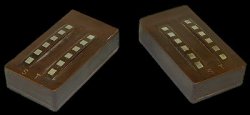
|
Some six months or more after creating the six single-coil pickups Dan designed the ST, or Sustain Treble pickup and
according to Dan it turned out to be his favorite. The ST pickup features two coils and is the first humbucker to
employ a ceramic magnet, and like the others, one of the first pickups ever to be potted.
|
The ST pickup is easily distinguishable from the other pickups in that it features two bar type pole pieces vs. the
usual single bar pole employed by the single coil pickups. Furthermore, the bar pole pieces are divided into
miniature 'squares' with the metal from the pole piece being exposed from the resin in exactly the place where the
instruments strings would lie. These twin rows of little 'squares' make a lasting impression and visually set the
ST apart from the rest of the pickups in this line.

|
What appears as a custom made dual blade pickup is in all likeliness a version of an ST pickup, only this particular
one has the brown resin encasing even the individual pole pieces. Also, unlike the stock ST pickup this one does not
feature the extra area where the letters ST are etched in. It appears totally original, but most likely a custom
ordered model, or an otherwise one of a kind pickup as Dan may have produced experimental units as he developed the
ST design. Photo courtesy of Bill Richardson.
|
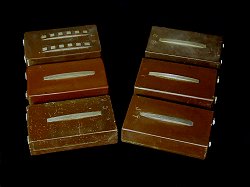
|
Seen at left, from front to back is the
Country Bass, Jazz Bass and Sustain Treble pickups. On the right,
from front to back is the
Jazz Treble, Rock Treble, and another Country Bass pickup. Missing
are the Country Treble & Rock Bass pickups.
Notice how 3 of the pickups have the appearance like that of milk chocolate while the other 3 more closely resemble the
look of a very old, crusty candy bar. This may be due to the date, or time frame that they were made in.
Notice too - how the Jazz Bass (middle left pickup) has no such lettering on it at all.
|
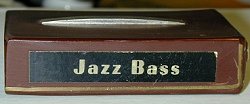
|
Years ago when I purchased some used Jazz pickups for my Dan Armstrong guitar I was surprised to find out that the
Jazz Bass pickup had no stamped-in letters on it at all. However, I saw a sticker on the sides of the pickup that said Jazz Bass
and I could tell by the way it looked, felt & sounded that it was genuine.
|
Over time I developed a theory about this label. The only logical conclusion that could be drawn was that the past
owner had perspired a lot and rubbed the lettering off with his playing as I have seen some major corrosion on various
guitars over the years and I thought this was the case here. Although it did dawn on me that with all that corrosion
going on I should have seen some sign of it beyond just the letters missing.
It came to me that the past owner must have simply cleaned up, and polished out any such corrosion and then made and
glued on a label to let him know which pickup it was. Being it was on the side of the pickup rather than the top it
shouldn't be affected by his playing like before. As smooth as the pickup sounds, everytime I slid it in and began to
enjoy its sweetness - lurking in the back of my mind was the simple fact that without the stamped in letters, the
pickup itself would always be somewhat devalued - as any modification devalues an instrument.
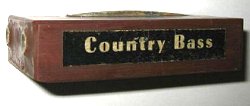
|
It was, then, quite a surprise when I received an email from Chad Coulter asking me about just such a pickup. He
included this photo and asked about the label. It didn't take a crack team of experts to discover that
the letters used to make up the word 'Bass' were of the same font size and style as my Jazz pickup. Photo courtesy of Chad Coulter.
|
I pondered my next move as I went over the facts one at a time in my mind, thinking..... two Dan Armstrong pickups,
both with the same black label on the sides, both with the same bronze colored lettering, both utilizing the exact font
style on those bronze colored letters, and both identifying the type of pickup - was a string of coincidences that simply
could not be ignored. To think that they had both once belonged to the same past owner who labelled all his pickups in
this manner was a stretch at best. As my former theory began to fade away I figured it was once again time to contact my friend
who I knew would have the answer.
An email was immediately sent to dan-armstrong@supanet.com with both photos - asking if he had any knowledge of this. A day or so later he
responded. It was fortunate that I was sitting down as I read it, for he stated "the labels were used on the
earliest of pickups, during the prototype stages, there can't be many of them still around." Apparently, as the
'snap in pickup' gave way to the banana plug design, the 'label on the side' soon gave way to the stamped in lettering
process. Far from being a devalued pickup the rarity of such pickups forces the value the other way.
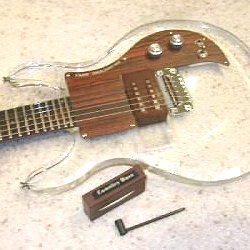
|
As seen at left, over the years I have seen a few Dan Armstrong · Ampeg pickups
with such a label as they come up from time to time on internet auction sites.
Shown here is another Country Bass pickup that I saw with a Dan Armstrong guitar online. I can't be certain
if the pickup came with this instrument or not, but it seems likely that it did.
|
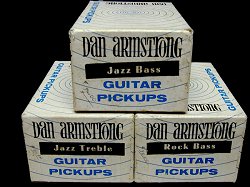
|
Ironically, and as can be seen at left, these very same labels were also used on the boxes that the
Dan Armstrong · Ampeg pickups came in if you happen to have ordered more than the
two that accompanied the instrument.
For those that may happen to still have these boxes - by running
your fingers over the box you can easily feel the raised label that was applied to designate the type of pickup within.
|

|
If you look again at the photo of the 6 pickups you may recall how I mentioned that 3 of them looked like milk
chocolate while the other 3 looked more like an old candy bar. One of the 'milk chocolate' ones is the Jazz Bass, the
pickup with the label (and also the middle left pickup). The other two that resemble it are the Jazz & Rock Treble
pickups - which are the middle and lower right pickups. While it is only speculation, one cannot help but wonder if
they are all somewhat older pickups being their outward appearance matches that of the Jazz Bass pickup which we now
know is one of the oldest.
|
Standing in sharp contrast are the other 3 pickups - the two Country Bass pickups and the Sustain Treble pickup. Since
it is well known that the ST pickup came later, one cannot help but wonder, then, if the other two pickups that match
the ST's outwardly appearance are newer pickups as well (relatively speaking). Most likely we will never know for
sure, but one thing is obvious, the outer resin differed in color from batch to batch.
continue
menu
Names and images are TMand © Dan Armstrong / Ampeg. All rights reserved.
All other names and images are TMand © of their respective owners. All rights reserved.
|
| |

